Charles Darwin University NUR250 Assessment 1: Bronchitis Care
VerifiedAdded on 2022/09/17
|12
|3133
|41
Homework Assignment
AI Summary
This assignment provides a comprehensive nursing care plan for a 59-year-old patient, Ms. Laura Purple, suffering from bronchitis, dyspnoea, and a history of asthma, obesity, hyperlipidaemia, type 2 diabetes mellitus, and substance abuse. The solution addresses the definition and pathophysiology of bronchitis, including the patient's presentation and past medical history. It details nursing care plans for the risk of infection, impaired tissue perfusion, and knowledge deficit. The care plans outline goals, nursing interventions, and rationales for each problem. Furthermore, the assignment covers patient education strategies, focusing on disease conditions, lifestyle changes, and medication management, including the use of Azithromycin and Salbutamol. The document also includes a discussion of the patient's current condition, past medical history, and the impact of smoking and drinking habits. The solution emphasizes the importance of lifestyle changes and patient education for successful self-management.
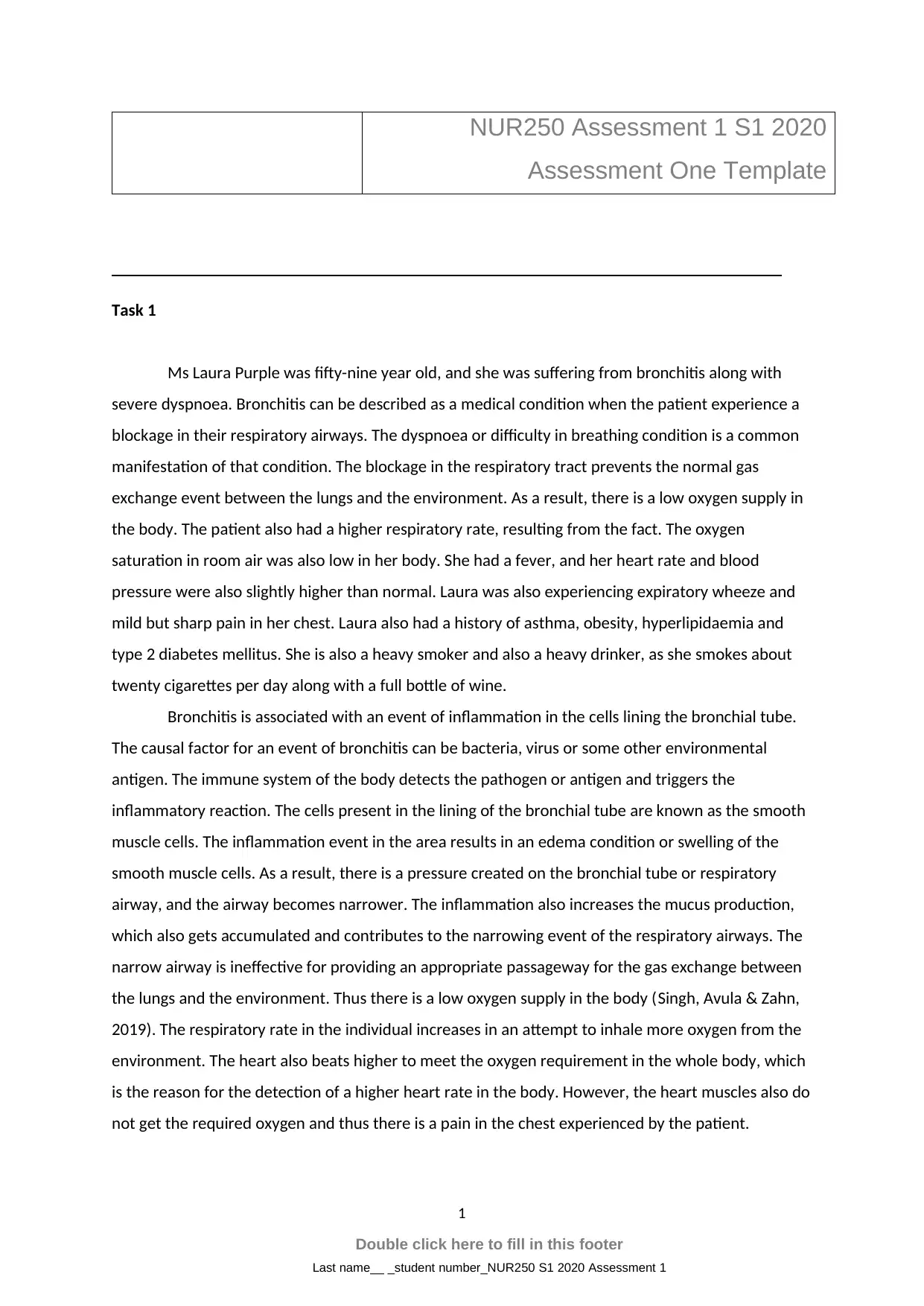
NUR250 Assessment 1 S1 2020
Assessment One Template
Task 1
Ms Laura Purple was fifty-nine year old, and she was suffering from bronchitis along with
severe dyspnoea. Bronchitis can be described as a medical condition when the patient experience a
blockage in their respiratory airways. The dyspnoea or difficulty in breathing condition is a common
manifestation of that condition. The blockage in the respiratory tract prevents the normal gas
exchange event between the lungs and the environment. As a result, there is a low oxygen supply in
the body. The patient also had a higher respiratory rate, resulting from the fact. The oxygen
saturation in room air was also low in her body. She had a fever, and her heart rate and blood
pressure were also slightly higher than normal. Laura was also experiencing expiratory wheeze and
mild but sharp pain in her chest. Laura also had a history of asthma, obesity, hyperlipidaemia and
type 2 diabetes mellitus. She is also a heavy smoker and also a heavy drinker, as she smokes about
twenty cigarettes per day along with a full bottle of wine.
Bronchitis is associated with an event of inflammation in the cells lining the bronchial tube.
The causal factor for an event of bronchitis can be bacteria, virus or some other environmental
antigen. The immune system of the body detects the pathogen or antigen and triggers the
inflammatory reaction. The cells present in the lining of the bronchial tube are known as the smooth
muscle cells. The inflammation event in the area results in an edema condition or swelling of the
smooth muscle cells. As a result, there is a pressure created on the bronchial tube or respiratory
airway, and the airway becomes narrower. The inflammation also increases the mucus production,
which also gets accumulated and contributes to the narrowing event of the respiratory airways. The
narrow airway is ineffective for providing an appropriate passageway for the gas exchange between
the lungs and the environment. Thus there is a low oxygen supply in the body (Singh, Avula & Zahn,
2019). The respiratory rate in the individual increases in an attempt to inhale more oxygen from the
environment. The heart also beats higher to meet the oxygen requirement in the whole body, which
is the reason for the detection of a higher heart rate in the body. However, the heart muscles also do
not get the required oxygen and thus there is a pain in the chest experienced by the patient.
1
Double click here to fill in this footer
Last name__ _student number_NUR250 S1 2020 Assessment 1
Assessment One Template
Task 1
Ms Laura Purple was fifty-nine year old, and she was suffering from bronchitis along with
severe dyspnoea. Bronchitis can be described as a medical condition when the patient experience a
blockage in their respiratory airways. The dyspnoea or difficulty in breathing condition is a common
manifestation of that condition. The blockage in the respiratory tract prevents the normal gas
exchange event between the lungs and the environment. As a result, there is a low oxygen supply in
the body. The patient also had a higher respiratory rate, resulting from the fact. The oxygen
saturation in room air was also low in her body. She had a fever, and her heart rate and blood
pressure were also slightly higher than normal. Laura was also experiencing expiratory wheeze and
mild but sharp pain in her chest. Laura also had a history of asthma, obesity, hyperlipidaemia and
type 2 diabetes mellitus. She is also a heavy smoker and also a heavy drinker, as she smokes about
twenty cigarettes per day along with a full bottle of wine.
Bronchitis is associated with an event of inflammation in the cells lining the bronchial tube.
The causal factor for an event of bronchitis can be bacteria, virus or some other environmental
antigen. The immune system of the body detects the pathogen or antigen and triggers the
inflammatory reaction. The cells present in the lining of the bronchial tube are known as the smooth
muscle cells. The inflammation event in the area results in an edema condition or swelling of the
smooth muscle cells. As a result, there is a pressure created on the bronchial tube or respiratory
airway, and the airway becomes narrower. The inflammation also increases the mucus production,
which also gets accumulated and contributes to the narrowing event of the respiratory airways. The
narrow airway is ineffective for providing an appropriate passageway for the gas exchange between
the lungs and the environment. Thus there is a low oxygen supply in the body (Singh, Avula & Zahn,
2019). The respiratory rate in the individual increases in an attempt to inhale more oxygen from the
environment. The heart also beats higher to meet the oxygen requirement in the whole body, which
is the reason for the detection of a higher heart rate in the body. However, the heart muscles also do
not get the required oxygen and thus there is a pain in the chest experienced by the patient.
1
Double click here to fill in this footer
Last name__ _student number_NUR250 S1 2020 Assessment 1
Paraphrase This Document
Need a fresh take? Get an instant paraphrase of this document with our AI Paraphraser
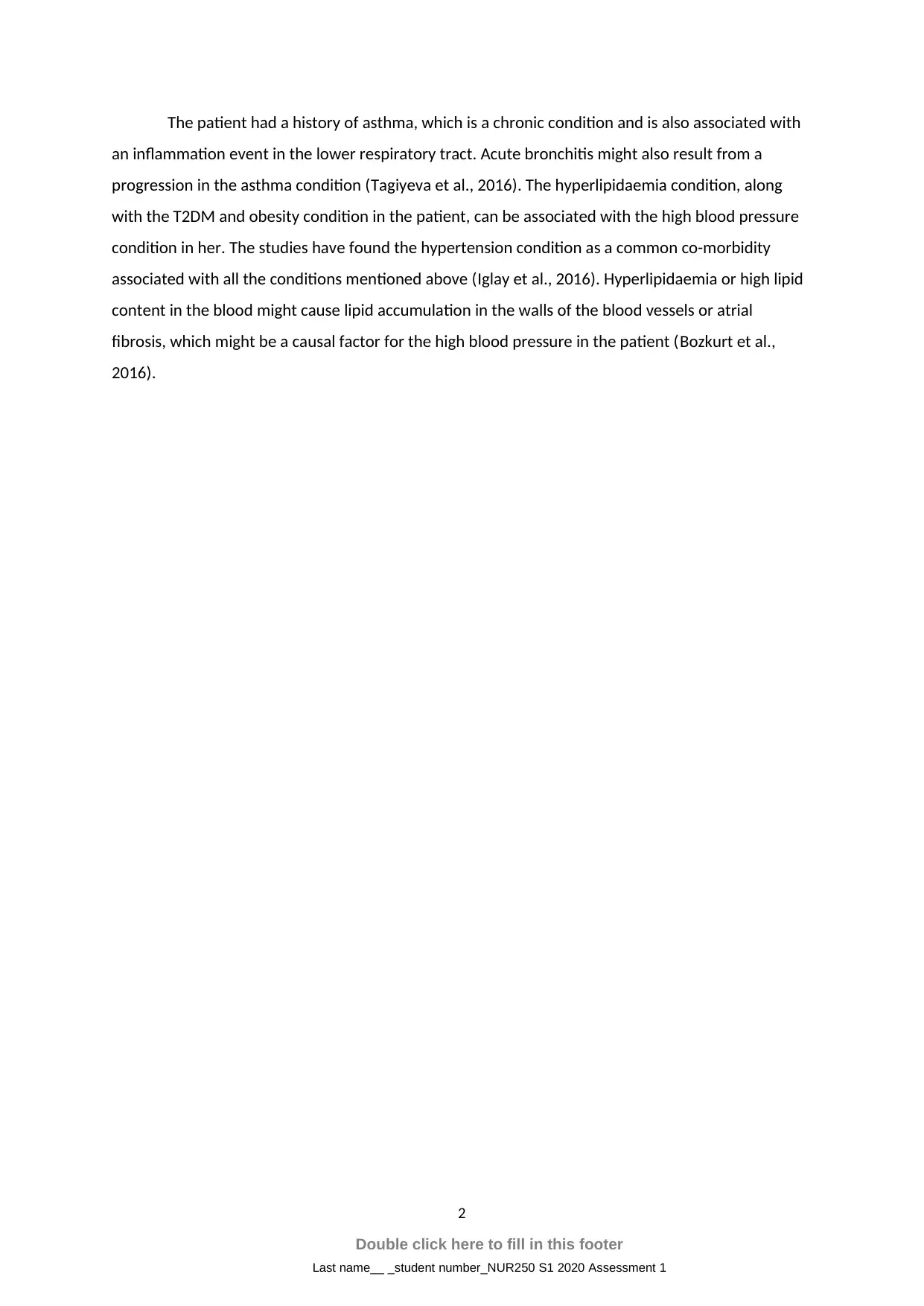
The patient had a history of asthma, which is a chronic condition and is also associated with
an inflammation event in the lower respiratory tract. Acute bronchitis might also result from a
progression in the asthma condition (Tagiyeva et al., 2016). The hyperlipidaemia condition, along
with the T2DM and obesity condition in the patient, can be associated with the high blood pressure
condition in her. The studies have found the hypertension condition as a common co-morbidity
associated with all the conditions mentioned above (Iglay et al., 2016). Hyperlipidaemia or high lipid
content in the blood might cause lipid accumulation in the walls of the blood vessels or atrial
fibrosis, which might be a causal factor for the high blood pressure in the patient (Bozkurt et al.,
2016).
2
Double click here to fill in this footer
Last name__ _student number_NUR250 S1 2020 Assessment 1
an inflammation event in the lower respiratory tract. Acute bronchitis might also result from a
progression in the asthma condition (Tagiyeva et al., 2016). The hyperlipidaemia condition, along
with the T2DM and obesity condition in the patient, can be associated with the high blood pressure
condition in her. The studies have found the hypertension condition as a common co-morbidity
associated with all the conditions mentioned above (Iglay et al., 2016). Hyperlipidaemia or high lipid
content in the blood might cause lipid accumulation in the walls of the blood vessels or atrial
fibrosis, which might be a causal factor for the high blood pressure in the patient (Bozkurt et al.,
2016).
2
Double click here to fill in this footer
Last name__ _student number_NUR250 S1 2020 Assessment 1
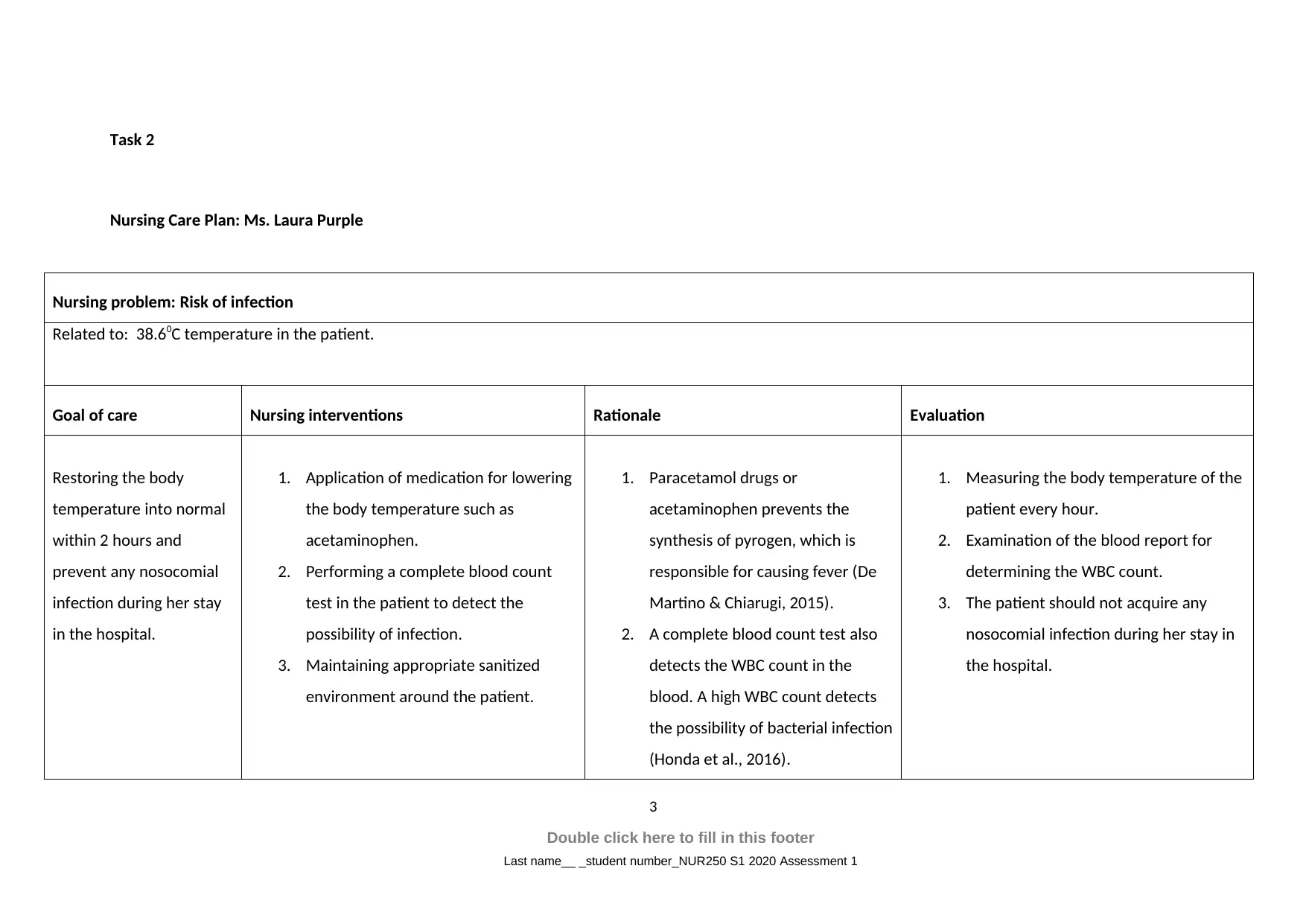
Task 2
Nursing Care Plan: Ms. Laura Purple
Nursing problem: Risk of infection
Related to: 38.60C temperature in the patient.
Goal of care Nursing interventions Rationale Evaluation
Restoring the body
temperature into normal
within 2 hours and
prevent any nosocomial
infection during her stay
in the hospital.
1. Application of medication for lowering
the body temperature such as
acetaminophen.
2. Performing a complete blood count
test in the patient to detect the
possibility of infection.
3. Maintaining appropriate sanitized
environment around the patient.
1. Paracetamol drugs or
acetaminophen prevents the
synthesis of pyrogen, which is
responsible for causing fever (De
Martino & Chiarugi, 2015).
2. A complete blood count test also
detects the WBC count in the
blood. A high WBC count detects
the possibility of bacterial infection
(Honda et al., 2016).
1. Measuring the body temperature of the
patient every hour.
2. Examination of the blood report for
determining the WBC count.
3. The patient should not acquire any
nosocomial infection during her stay in
the hospital.
3
Double click here to fill in this footer
Last name__ _student number_NUR250 S1 2020 Assessment 1
Nursing Care Plan: Ms. Laura Purple
Nursing problem: Risk of infection
Related to: 38.60C temperature in the patient.
Goal of care Nursing interventions Rationale Evaluation
Restoring the body
temperature into normal
within 2 hours and
prevent any nosocomial
infection during her stay
in the hospital.
1. Application of medication for lowering
the body temperature such as
acetaminophen.
2. Performing a complete blood count
test in the patient to detect the
possibility of infection.
3. Maintaining appropriate sanitized
environment around the patient.
1. Paracetamol drugs or
acetaminophen prevents the
synthesis of pyrogen, which is
responsible for causing fever (De
Martino & Chiarugi, 2015).
2. A complete blood count test also
detects the WBC count in the
blood. A high WBC count detects
the possibility of bacterial infection
(Honda et al., 2016).
1. Measuring the body temperature of the
patient every hour.
2. Examination of the blood report for
determining the WBC count.
3. The patient should not acquire any
nosocomial infection during her stay in
the hospital.
3
Double click here to fill in this footer
Last name__ _student number_NUR250 S1 2020 Assessment 1
⊘ This is a preview!⊘
Do you want full access?
Subscribe today to unlock all pages.

Trusted by 1+ million students worldwide
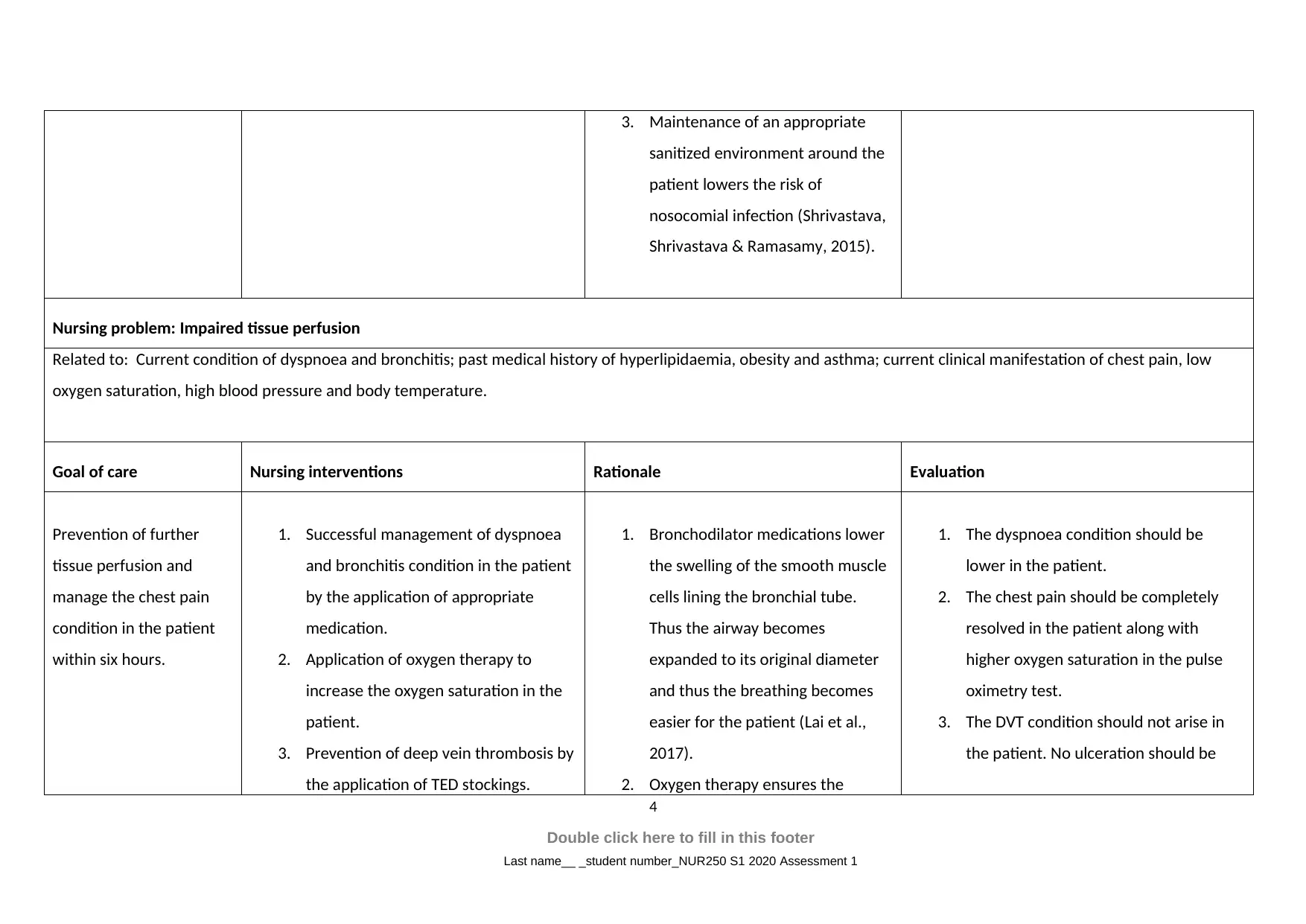
3. Maintenance of an appropriate
sanitized environment around the
patient lowers the risk of
nosocomial infection (Shrivastava,
Shrivastava & Ramasamy, 2015).
Nursing problem: Impaired tissue perfusion
Related to: Current condition of dyspnoea and bronchitis; past medical history of hyperlipidaemia, obesity and asthma; current clinical manifestation of chest pain, low
oxygen saturation, high blood pressure and body temperature.
Goal of care Nursing interventions Rationale Evaluation
Prevention of further
tissue perfusion and
manage the chest pain
condition in the patient
within six hours.
1. Successful management of dyspnoea
and bronchitis condition in the patient
by the application of appropriate
medication.
2. Application of oxygen therapy to
increase the oxygen saturation in the
patient.
3. Prevention of deep vein thrombosis by
the application of TED stockings.
1. Bronchodilator medications lower
the swelling of the smooth muscle
cells lining the bronchial tube.
Thus the airway becomes
expanded to its original diameter
and thus the breathing becomes
easier for the patient (Lai et al.,
2017).
2. Oxygen therapy ensures the
1. The dyspnoea condition should be
lower in the patient.
2. The chest pain should be completely
resolved in the patient along with
higher oxygen saturation in the pulse
oximetry test.
3. The DVT condition should not arise in
the patient. No ulceration should be
4
Double click here to fill in this footer
Last name__ _student number_NUR250 S1 2020 Assessment 1
sanitized environment around the
patient lowers the risk of
nosocomial infection (Shrivastava,
Shrivastava & Ramasamy, 2015).
Nursing problem: Impaired tissue perfusion
Related to: Current condition of dyspnoea and bronchitis; past medical history of hyperlipidaemia, obesity and asthma; current clinical manifestation of chest pain, low
oxygen saturation, high blood pressure and body temperature.
Goal of care Nursing interventions Rationale Evaluation
Prevention of further
tissue perfusion and
manage the chest pain
condition in the patient
within six hours.
1. Successful management of dyspnoea
and bronchitis condition in the patient
by the application of appropriate
medication.
2. Application of oxygen therapy to
increase the oxygen saturation in the
patient.
3. Prevention of deep vein thrombosis by
the application of TED stockings.
1. Bronchodilator medications lower
the swelling of the smooth muscle
cells lining the bronchial tube.
Thus the airway becomes
expanded to its original diameter
and thus the breathing becomes
easier for the patient (Lai et al.,
2017).
2. Oxygen therapy ensures the
1. The dyspnoea condition should be
lower in the patient.
2. The chest pain should be completely
resolved in the patient along with
higher oxygen saturation in the pulse
oximetry test.
3. The DVT condition should not arise in
the patient. No ulceration should be
4
Double click here to fill in this footer
Last name__ _student number_NUR250 S1 2020 Assessment 1
Paraphrase This Document
Need a fresh take? Get an instant paraphrase of this document with our AI Paraphraser
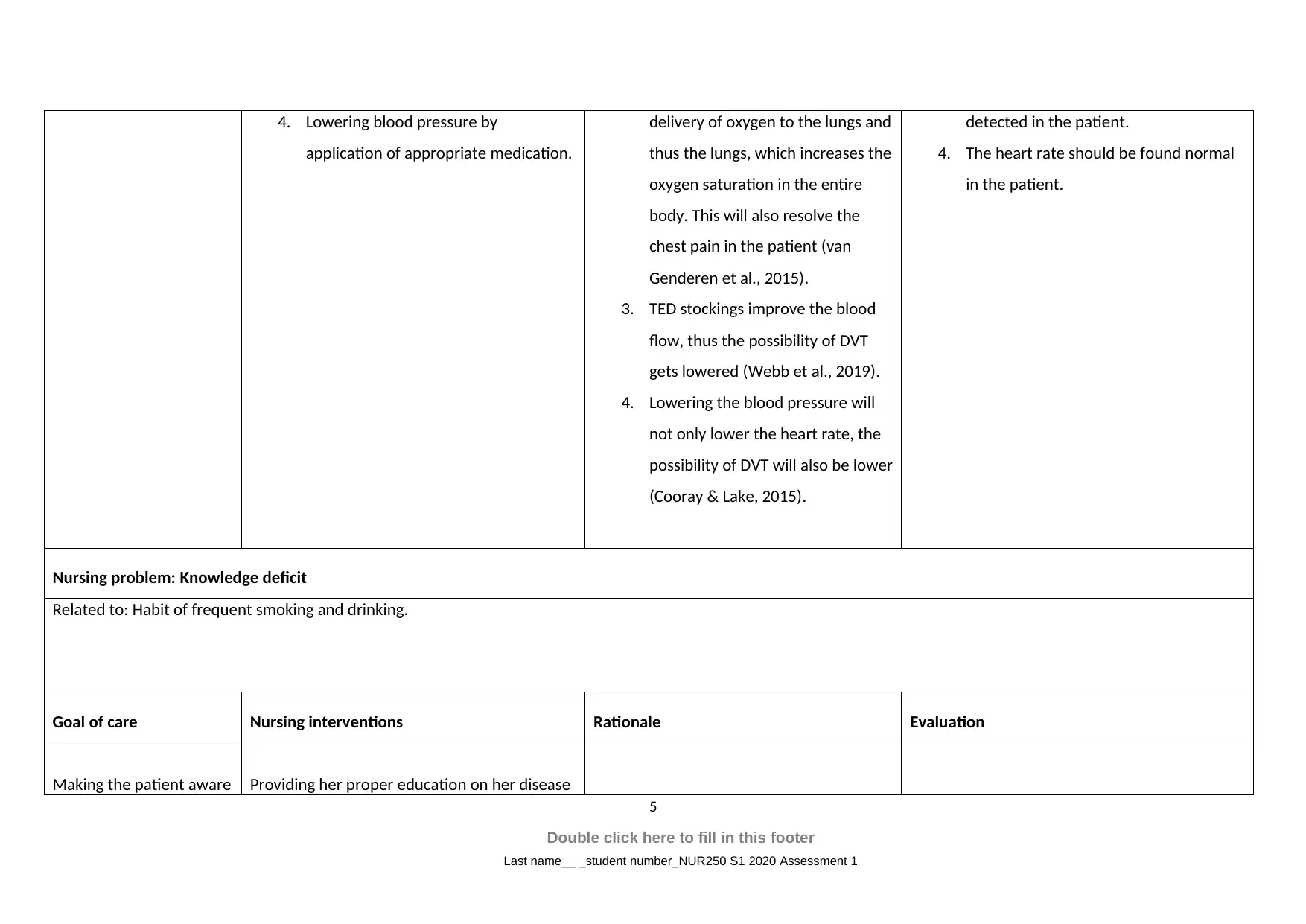
4. Lowering blood pressure by
application of appropriate medication.
delivery of oxygen to the lungs and
thus the lungs, which increases the
oxygen saturation in the entire
body. This will also resolve the
chest pain in the patient (van
Genderen et al., 2015).
3. TED stockings improve the blood
flow, thus the possibility of DVT
gets lowered (Webb et al., 2019).
4. Lowering the blood pressure will
not only lower the heart rate, the
possibility of DVT will also be lower
(Cooray & Lake, 2015).
detected in the patient.
4. The heart rate should be found normal
in the patient.
Nursing problem: Knowledge deficit
Related to: Habit of frequent smoking and drinking.
Goal of care Nursing interventions Rationale Evaluation
Making the patient aware Providing her proper education on her disease
5
Double click here to fill in this footer
Last name__ _student number_NUR250 S1 2020 Assessment 1
application of appropriate medication.
delivery of oxygen to the lungs and
thus the lungs, which increases the
oxygen saturation in the entire
body. This will also resolve the
chest pain in the patient (van
Genderen et al., 2015).
3. TED stockings improve the blood
flow, thus the possibility of DVT
gets lowered (Webb et al., 2019).
4. Lowering the blood pressure will
not only lower the heart rate, the
possibility of DVT will also be lower
(Cooray & Lake, 2015).
detected in the patient.
4. The heart rate should be found normal
in the patient.
Nursing problem: Knowledge deficit
Related to: Habit of frequent smoking and drinking.
Goal of care Nursing interventions Rationale Evaluation
Making the patient aware Providing her proper education on her disease
5
Double click here to fill in this footer
Last name__ _student number_NUR250 S1 2020 Assessment 1
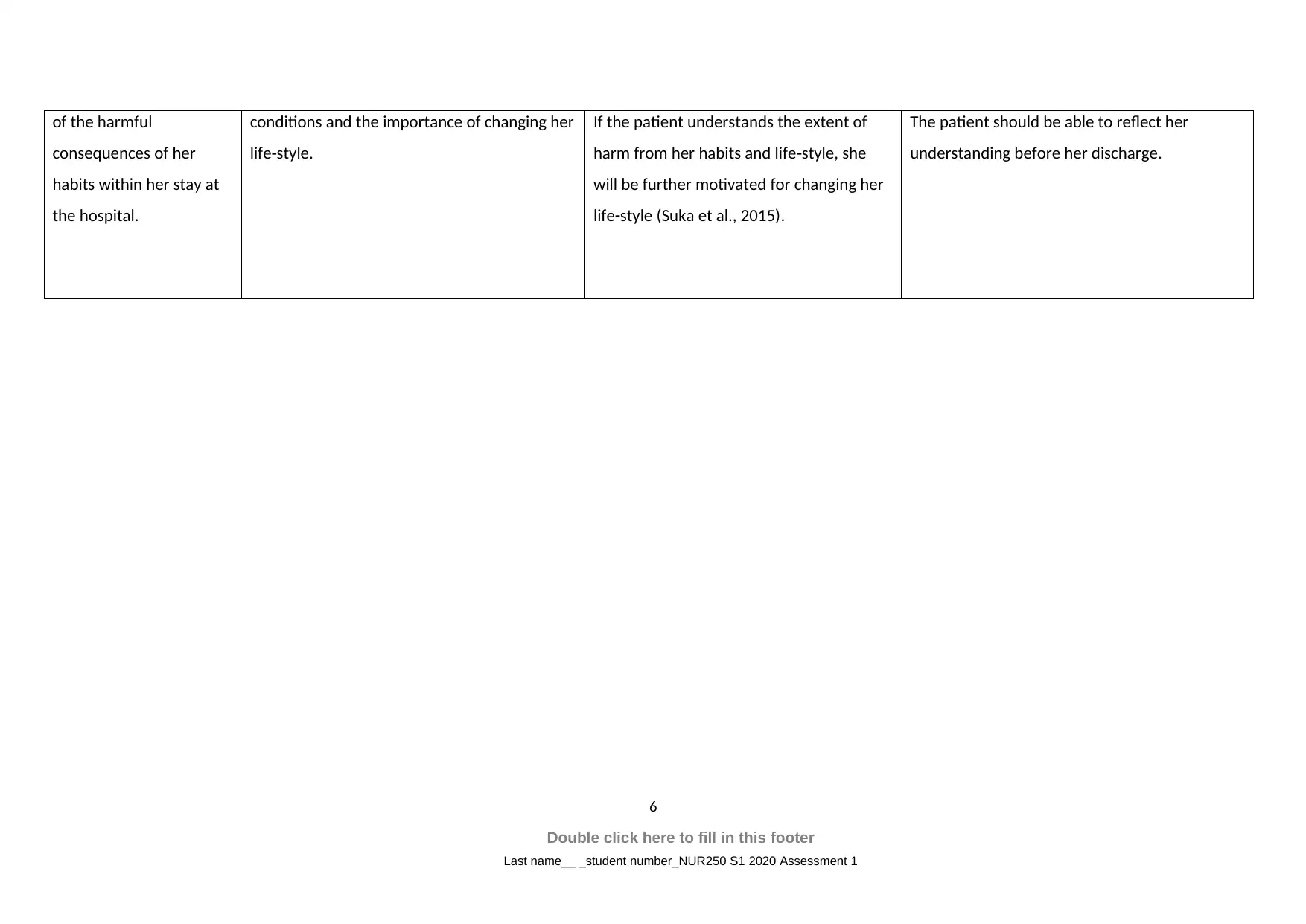
of the harmful
consequences of her
habits within her stay at
the hospital.
conditions and the importance of changing her
life-style.
If the patient understands the extent of
harm from her habits and life-style, she
will be further motivated for changing her
life-style (Suka et al., 2015).
The patient should be able to reflect her
understanding before her discharge.
6
Double click here to fill in this footer
Last name__ _student number_NUR250 S1 2020 Assessment 1
consequences of her
habits within her stay at
the hospital.
conditions and the importance of changing her
life-style.
If the patient understands the extent of
harm from her habits and life-style, she
will be further motivated for changing her
life-style (Suka et al., 2015).
The patient should be able to reflect her
understanding before her discharge.
6
Double click here to fill in this footer
Last name__ _student number_NUR250 S1 2020 Assessment 1
⊘ This is a preview!⊘
Do you want full access?
Subscribe today to unlock all pages.

Trusted by 1+ million students worldwide
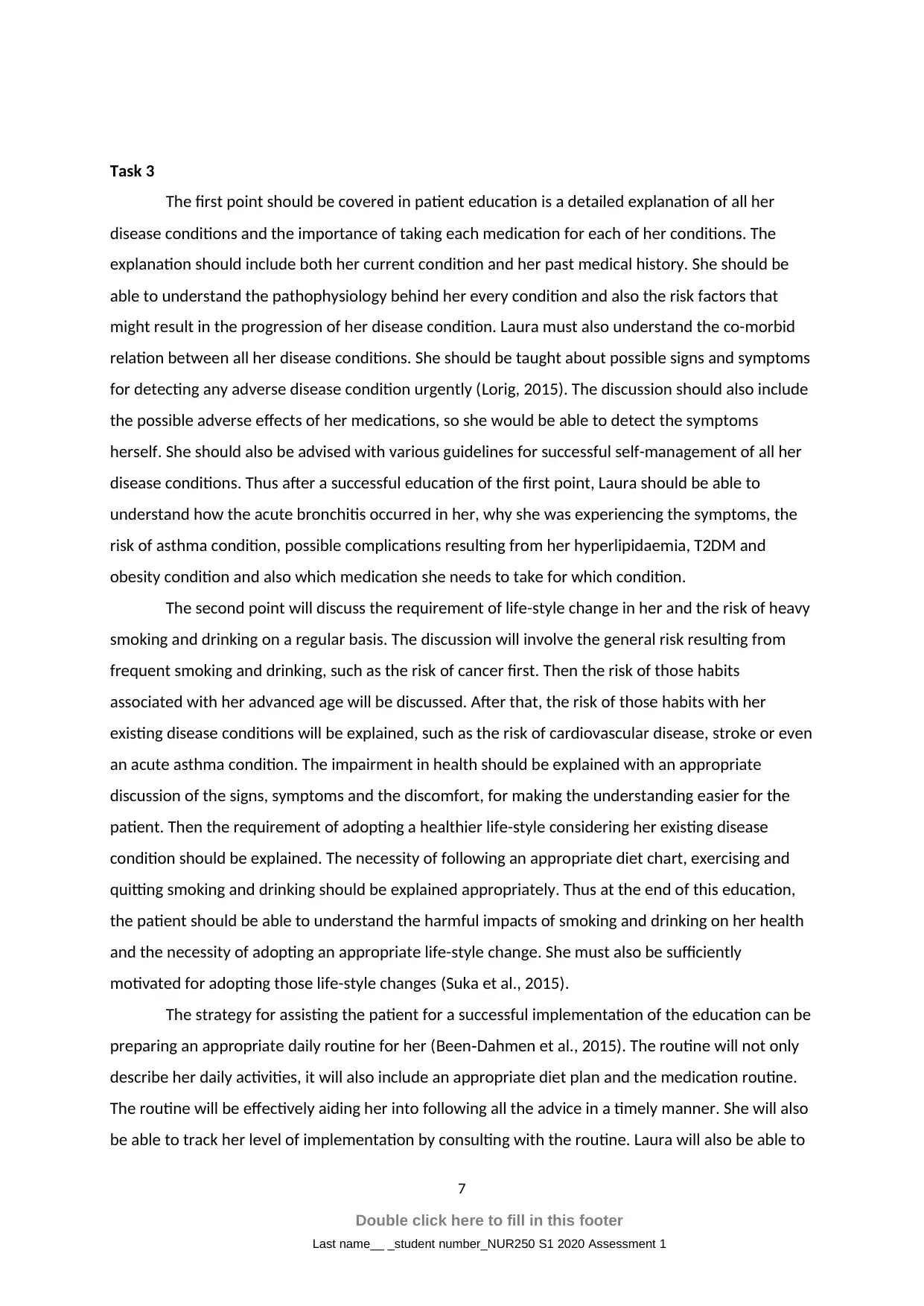
Task 3
The first point should be covered in patient education is a detailed explanation of all her
disease conditions and the importance of taking each medication for each of her conditions. The
explanation should include both her current condition and her past medical history. She should be
able to understand the pathophysiology behind her every condition and also the risk factors that
might result in the progression of her disease condition. Laura must also understand the co-morbid
relation between all her disease conditions. She should be taught about possible signs and symptoms
for detecting any adverse disease condition urgently (Lorig, 2015). The discussion should also include
the possible adverse effects of her medications, so she would be able to detect the symptoms
herself. She should also be advised with various guidelines for successful self-management of all her
disease conditions. Thus after a successful education of the first point, Laura should be able to
understand how the acute bronchitis occurred in her, why she was experiencing the symptoms, the
risk of asthma condition, possible complications resulting from her hyperlipidaemia, T2DM and
obesity condition and also which medication she needs to take for which condition.
The second point will discuss the requirement of life-style change in her and the risk of heavy
smoking and drinking on a regular basis. The discussion will involve the general risk resulting from
frequent smoking and drinking, such as the risk of cancer first. Then the risk of those habits
associated with her advanced age will be discussed. After that, the risk of those habits with her
existing disease conditions will be explained, such as the risk of cardiovascular disease, stroke or even
an acute asthma condition. The impairment in health should be explained with an appropriate
discussion of the signs, symptoms and the discomfort, for making the understanding easier for the
patient. Then the requirement of adopting a healthier life-style considering her existing disease
condition should be explained. The necessity of following an appropriate diet chart, exercising and
quitting smoking and drinking should be explained appropriately. Thus at the end of this education,
the patient should be able to understand the harmful impacts of smoking and drinking on her health
and the necessity of adopting an appropriate life-style change. She must also be sufficiently
motivated for adopting those life-style changes (Suka et al., 2015).
The strategy for assisting the patient for a successful implementation of the education can be
preparing an appropriate daily routine for her (Been‐Dahmen et al., 2015). The routine will not only
describe her daily activities, it will also include an appropriate diet plan and the medication routine.
The routine will be effectively aiding her into following all the advice in a timely manner. She will also
be able to track her level of implementation by consulting with the routine. Laura will also be able to
7
Double click here to fill in this footer
Last name__ _student number_NUR250 S1 2020 Assessment 1
The first point should be covered in patient education is a detailed explanation of all her
disease conditions and the importance of taking each medication for each of her conditions. The
explanation should include both her current condition and her past medical history. She should be
able to understand the pathophysiology behind her every condition and also the risk factors that
might result in the progression of her disease condition. Laura must also understand the co-morbid
relation between all her disease conditions. She should be taught about possible signs and symptoms
for detecting any adverse disease condition urgently (Lorig, 2015). The discussion should also include
the possible adverse effects of her medications, so she would be able to detect the symptoms
herself. She should also be advised with various guidelines for successful self-management of all her
disease conditions. Thus after a successful education of the first point, Laura should be able to
understand how the acute bronchitis occurred in her, why she was experiencing the symptoms, the
risk of asthma condition, possible complications resulting from her hyperlipidaemia, T2DM and
obesity condition and also which medication she needs to take for which condition.
The second point will discuss the requirement of life-style change in her and the risk of heavy
smoking and drinking on a regular basis. The discussion will involve the general risk resulting from
frequent smoking and drinking, such as the risk of cancer first. Then the risk of those habits
associated with her advanced age will be discussed. After that, the risk of those habits with her
existing disease conditions will be explained, such as the risk of cardiovascular disease, stroke or even
an acute asthma condition. The impairment in health should be explained with an appropriate
discussion of the signs, symptoms and the discomfort, for making the understanding easier for the
patient. Then the requirement of adopting a healthier life-style considering her existing disease
condition should be explained. The necessity of following an appropriate diet chart, exercising and
quitting smoking and drinking should be explained appropriately. Thus at the end of this education,
the patient should be able to understand the harmful impacts of smoking and drinking on her health
and the necessity of adopting an appropriate life-style change. She must also be sufficiently
motivated for adopting those life-style changes (Suka et al., 2015).
The strategy for assisting the patient for a successful implementation of the education can be
preparing an appropriate daily routine for her (Been‐Dahmen et al., 2015). The routine will not only
describe her daily activities, it will also include an appropriate diet plan and the medication routine.
The routine will be effectively aiding her into following all the advice in a timely manner. She will also
be able to track her level of implementation by consulting with the routine. Laura will also be able to
7
Double click here to fill in this footer
Last name__ _student number_NUR250 S1 2020 Assessment 1
Paraphrase This Document
Need a fresh take? Get an instant paraphrase of this document with our AI Paraphraser
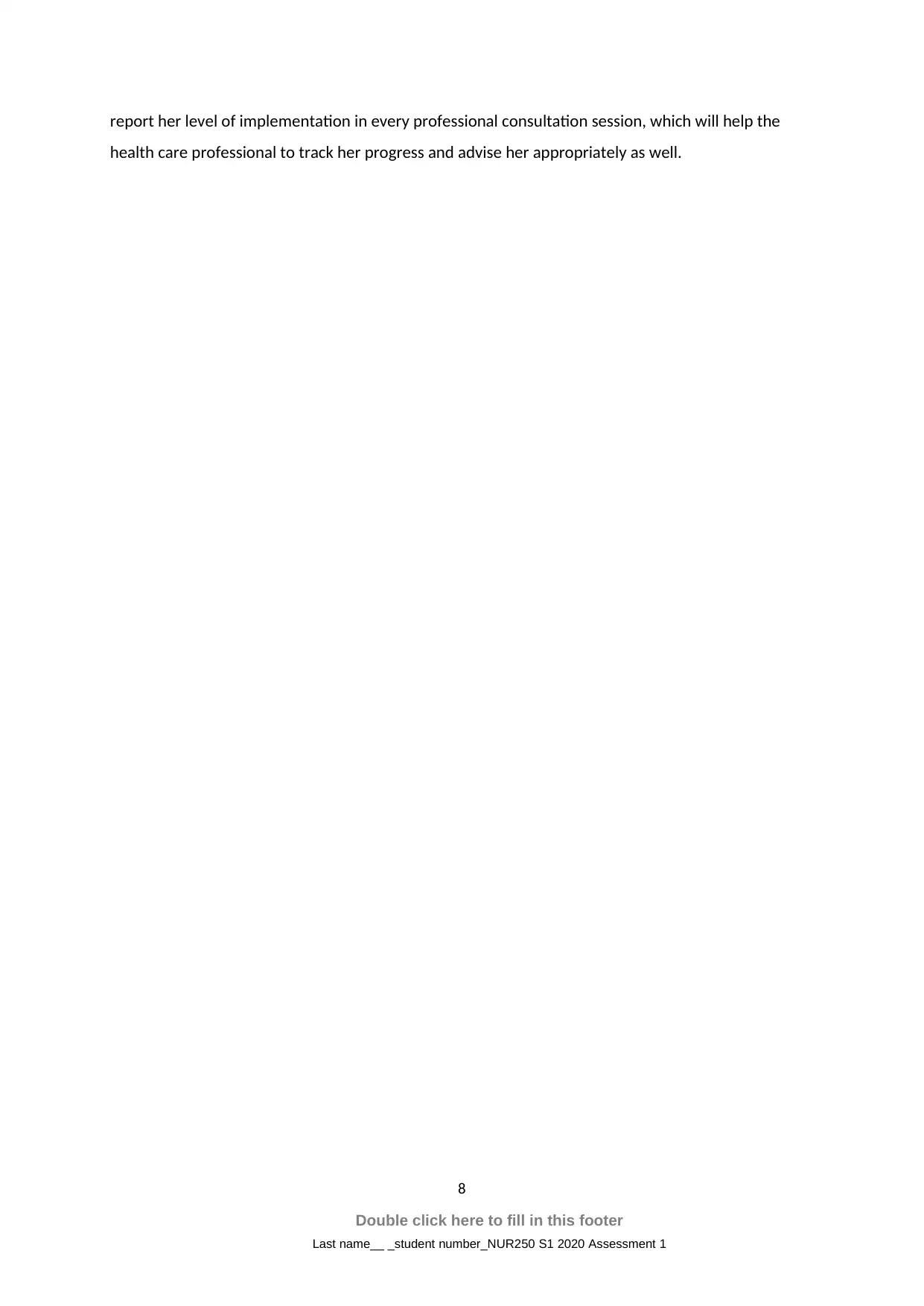
report her level of implementation in every professional consultation session, which will help the
health care professional to track her progress and advise her appropriately as well.
8
Double click here to fill in this footer
Last name__ _student number_NUR250 S1 2020 Assessment 1
health care professional to track her progress and advise her appropriately as well.
8
Double click here to fill in this footer
Last name__ _student number_NUR250 S1 2020 Assessment 1
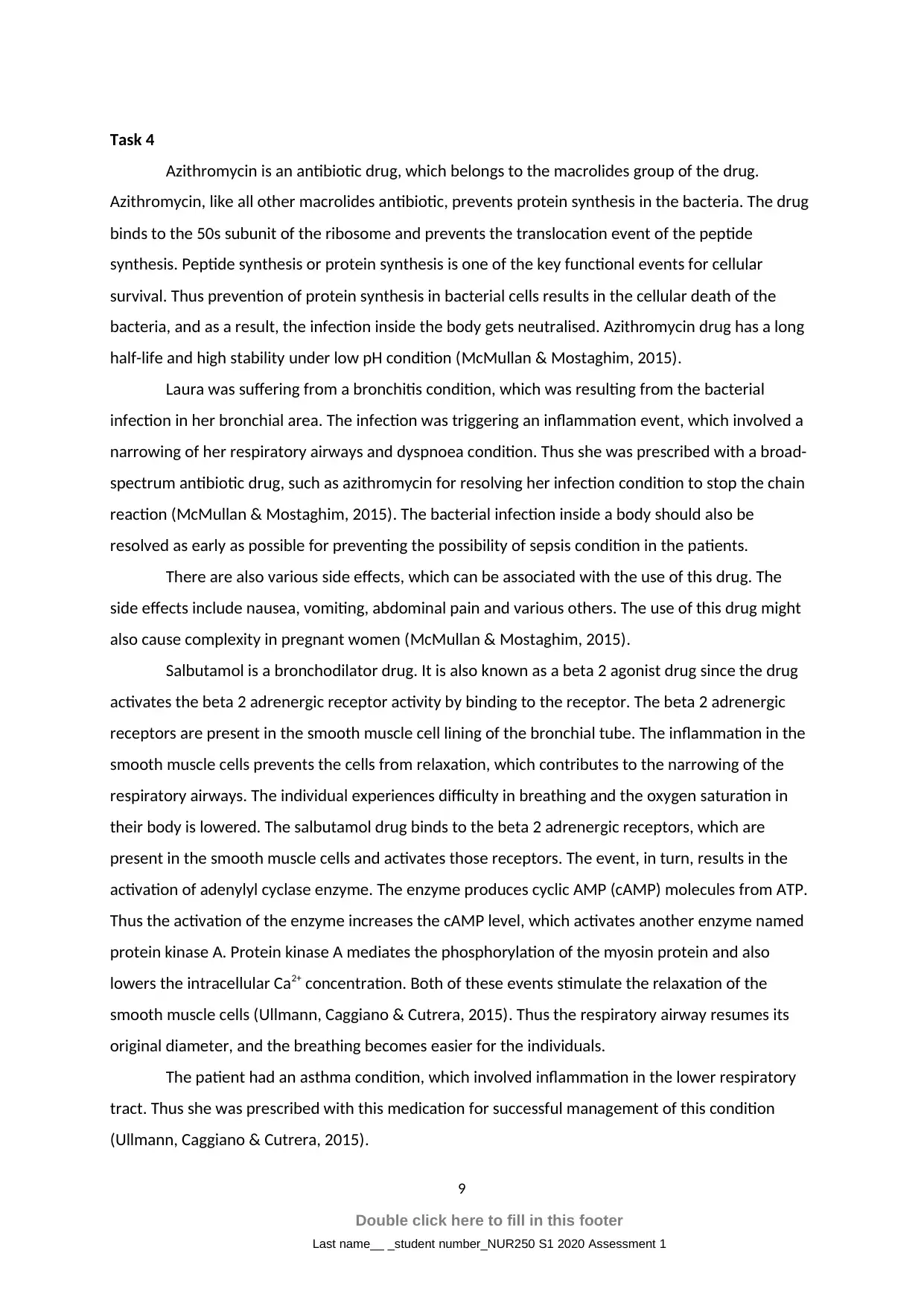
Task 4
Azithromycin is an antibiotic drug, which belongs to the macrolides group of the drug.
Azithromycin, like all other macrolides antibiotic, prevents protein synthesis in the bacteria. The drug
binds to the 50s subunit of the ribosome and prevents the translocation event of the peptide
synthesis. Peptide synthesis or protein synthesis is one of the key functional events for cellular
survival. Thus prevention of protein synthesis in bacterial cells results in the cellular death of the
bacteria, and as a result, the infection inside the body gets neutralised. Azithromycin drug has a long
half-life and high stability under low pH condition (McMullan & Mostaghim, 2015).
Laura was suffering from a bronchitis condition, which was resulting from the bacterial
infection in her bronchial area. The infection was triggering an inflammation event, which involved a
narrowing of her respiratory airways and dyspnoea condition. Thus she was prescribed with a broad-
spectrum antibiotic drug, such as azithromycin for resolving her infection condition to stop the chain
reaction (McMullan & Mostaghim, 2015). The bacterial infection inside a body should also be
resolved as early as possible for preventing the possibility of sepsis condition in the patients.
There are also various side effects, which can be associated with the use of this drug. The
side effects include nausea, vomiting, abdominal pain and various others. The use of this drug might
also cause complexity in pregnant women (McMullan & Mostaghim, 2015).
Salbutamol is a bronchodilator drug. It is also known as a beta 2 agonist drug since the drug
activates the beta 2 adrenergic receptor activity by binding to the receptor. The beta 2 adrenergic
receptors are present in the smooth muscle cell lining of the bronchial tube. The inflammation in the
smooth muscle cells prevents the cells from relaxation, which contributes to the narrowing of the
respiratory airways. The individual experiences difficulty in breathing and the oxygen saturation in
their body is lowered. The salbutamol drug binds to the beta 2 adrenergic receptors, which are
present in the smooth muscle cells and activates those receptors. The event, in turn, results in the
activation of adenylyl cyclase enzyme. The enzyme produces cyclic AMP (cAMP) molecules from ATP.
Thus the activation of the enzyme increases the cAMP level, which activates another enzyme named
protein kinase A. Protein kinase A mediates the phosphorylation of the myosin protein and also
lowers the intracellular Ca2+ concentration. Both of these events stimulate the relaxation of the
smooth muscle cells (Ullmann, Caggiano & Cutrera, 2015). Thus the respiratory airway resumes its
original diameter, and the breathing becomes easier for the individuals.
The patient had an asthma condition, which involved inflammation in the lower respiratory
tract. Thus she was prescribed with this medication for successful management of this condition
(Ullmann, Caggiano & Cutrera, 2015).
9
Double click here to fill in this footer
Last name__ _student number_NUR250 S1 2020 Assessment 1
Azithromycin is an antibiotic drug, which belongs to the macrolides group of the drug.
Azithromycin, like all other macrolides antibiotic, prevents protein synthesis in the bacteria. The drug
binds to the 50s subunit of the ribosome and prevents the translocation event of the peptide
synthesis. Peptide synthesis or protein synthesis is one of the key functional events for cellular
survival. Thus prevention of protein synthesis in bacterial cells results in the cellular death of the
bacteria, and as a result, the infection inside the body gets neutralised. Azithromycin drug has a long
half-life and high stability under low pH condition (McMullan & Mostaghim, 2015).
Laura was suffering from a bronchitis condition, which was resulting from the bacterial
infection in her bronchial area. The infection was triggering an inflammation event, which involved a
narrowing of her respiratory airways and dyspnoea condition. Thus she was prescribed with a broad-
spectrum antibiotic drug, such as azithromycin for resolving her infection condition to stop the chain
reaction (McMullan & Mostaghim, 2015). The bacterial infection inside a body should also be
resolved as early as possible for preventing the possibility of sepsis condition in the patients.
There are also various side effects, which can be associated with the use of this drug. The
side effects include nausea, vomiting, abdominal pain and various others. The use of this drug might
also cause complexity in pregnant women (McMullan & Mostaghim, 2015).
Salbutamol is a bronchodilator drug. It is also known as a beta 2 agonist drug since the drug
activates the beta 2 adrenergic receptor activity by binding to the receptor. The beta 2 adrenergic
receptors are present in the smooth muscle cell lining of the bronchial tube. The inflammation in the
smooth muscle cells prevents the cells from relaxation, which contributes to the narrowing of the
respiratory airways. The individual experiences difficulty in breathing and the oxygen saturation in
their body is lowered. The salbutamol drug binds to the beta 2 adrenergic receptors, which are
present in the smooth muscle cells and activates those receptors. The event, in turn, results in the
activation of adenylyl cyclase enzyme. The enzyme produces cyclic AMP (cAMP) molecules from ATP.
Thus the activation of the enzyme increases the cAMP level, which activates another enzyme named
protein kinase A. Protein kinase A mediates the phosphorylation of the myosin protein and also
lowers the intracellular Ca2+ concentration. Both of these events stimulate the relaxation of the
smooth muscle cells (Ullmann, Caggiano & Cutrera, 2015). Thus the respiratory airway resumes its
original diameter, and the breathing becomes easier for the individuals.
The patient had an asthma condition, which involved inflammation in the lower respiratory
tract. Thus she was prescribed with this medication for successful management of this condition
(Ullmann, Caggiano & Cutrera, 2015).
9
Double click here to fill in this footer
Last name__ _student number_NUR250 S1 2020 Assessment 1
⊘ This is a preview!⊘
Do you want full access?
Subscribe today to unlock all pages.

Trusted by 1+ million students worldwide
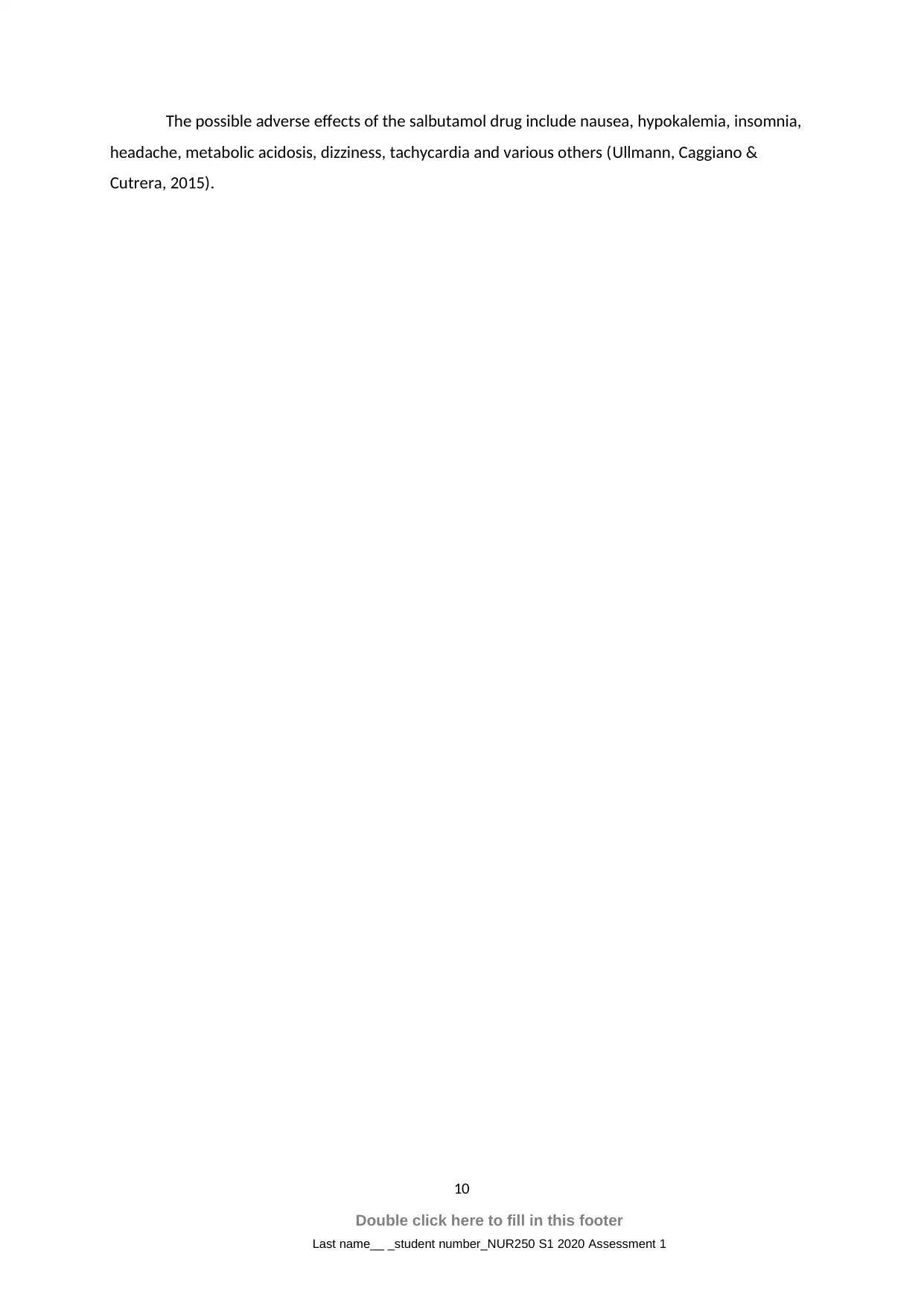
The possible adverse effects of the salbutamol drug include nausea, hypokalemia, insomnia,
headache, metabolic acidosis, dizziness, tachycardia and various others (Ullmann, Caggiano &
Cutrera, 2015).
10
Double click here to fill in this footer
Last name__ _student number_NUR250 S1 2020 Assessment 1
headache, metabolic acidosis, dizziness, tachycardia and various others (Ullmann, Caggiano &
Cutrera, 2015).
10
Double click here to fill in this footer
Last name__ _student number_NUR250 S1 2020 Assessment 1
Paraphrase This Document
Need a fresh take? Get an instant paraphrase of this document with our AI Paraphraser
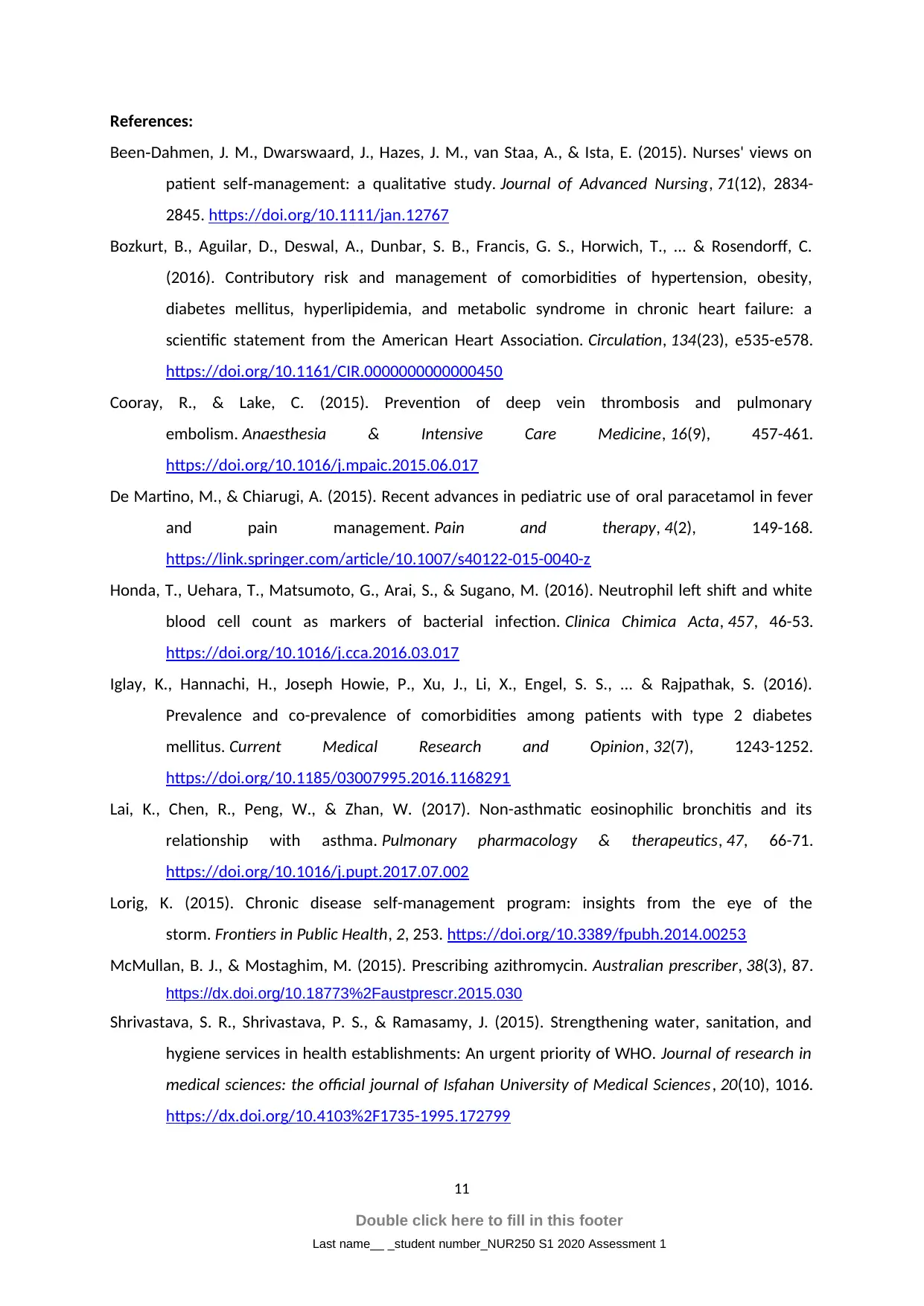
References:
Been‐Dahmen, J. M., Dwarswaard, J., Hazes, J. M., van Staa, A., & Ista, E. (2015). Nurses' views on
patient self‐management: a qualitative study. Journal of Advanced Nursing, 71(12), 2834-
2845. https://doi.org/10.1111/jan.12767
Bozkurt, B., Aguilar, D., Deswal, A., Dunbar, S. B., Francis, G. S., Horwich, T., ... & Rosendorff, C.
(2016). Contributory risk and management of comorbidities of hypertension, obesity,
diabetes mellitus, hyperlipidemia, and metabolic syndrome in chronic heart failure: a
scientific statement from the American Heart Association. Circulation, 134(23), e535-e578.
https://doi.org/10.1161/CIR.0000000000000450
Cooray, R., & Lake, C. (2015). Prevention of deep vein thrombosis and pulmonary
embolism. Anaesthesia & Intensive Care Medicine, 16(9), 457-461.
https://doi.org/10.1016/j.mpaic.2015.06.017
De Martino, M., & Chiarugi, A. (2015). Recent advances in pediatric use of oral paracetamol in fever
and pain management. Pain and therapy, 4(2), 149-168.
https://link.springer.com/article/10.1007/s40122-015-0040-z
Honda, T., Uehara, T., Matsumoto, G., Arai, S., & Sugano, M. (2016). Neutrophil left shift and white
blood cell count as markers of bacterial infection. Clinica Chimica Acta, 457, 46-53.
https://doi.org/10.1016/j.cca.2016.03.017
Iglay, K., Hannachi, H., Joseph Howie, P., Xu, J., Li, X., Engel, S. S., ... & Rajpathak, S. (2016).
Prevalence and co-prevalence of comorbidities among patients with type 2 diabetes
mellitus. Current Medical Research and Opinion, 32(7), 1243-1252.
https://doi.org/10.1185/03007995.2016.1168291
Lai, K., Chen, R., Peng, W., & Zhan, W. (2017). Non-asthmatic eosinophilic bronchitis and its
relationship with asthma. Pulmonary pharmacology & therapeutics, 47, 66-71.
https://doi.org/10.1016/j.pupt.2017.07.002
Lorig, K. (2015). Chronic disease self-management program: insights from the eye of the
storm. Frontiers in Public Health, 2, 253. https://doi.org/10.3389/fpubh.2014.00253
McMullan, B. J., & Mostaghim, M. (2015). Prescribing azithromycin. Australian prescriber, 38(3), 87.
https://dx.doi.org/10.18773%2Faustprescr.2015.030
Shrivastava, S. R., Shrivastava, P. S., & Ramasamy, J. (2015). Strengthening water, sanitation, and
hygiene services in health establishments: An urgent priority of WHO. Journal of research in
medical sciences: the official journal of Isfahan University of Medical Sciences, 20(10), 1016.
https://dx.doi.org/10.4103%2F1735-1995.172799
11
Double click here to fill in this footer
Last name__ _student number_NUR250 S1 2020 Assessment 1
Been‐Dahmen, J. M., Dwarswaard, J., Hazes, J. M., van Staa, A., & Ista, E. (2015). Nurses' views on
patient self‐management: a qualitative study. Journal of Advanced Nursing, 71(12), 2834-
2845. https://doi.org/10.1111/jan.12767
Bozkurt, B., Aguilar, D., Deswal, A., Dunbar, S. B., Francis, G. S., Horwich, T., ... & Rosendorff, C.
(2016). Contributory risk and management of comorbidities of hypertension, obesity,
diabetes mellitus, hyperlipidemia, and metabolic syndrome in chronic heart failure: a
scientific statement from the American Heart Association. Circulation, 134(23), e535-e578.
https://doi.org/10.1161/CIR.0000000000000450
Cooray, R., & Lake, C. (2015). Prevention of deep vein thrombosis and pulmonary
embolism. Anaesthesia & Intensive Care Medicine, 16(9), 457-461.
https://doi.org/10.1016/j.mpaic.2015.06.017
De Martino, M., & Chiarugi, A. (2015). Recent advances in pediatric use of oral paracetamol in fever
and pain management. Pain and therapy, 4(2), 149-168.
https://link.springer.com/article/10.1007/s40122-015-0040-z
Honda, T., Uehara, T., Matsumoto, G., Arai, S., & Sugano, M. (2016). Neutrophil left shift and white
blood cell count as markers of bacterial infection. Clinica Chimica Acta, 457, 46-53.
https://doi.org/10.1016/j.cca.2016.03.017
Iglay, K., Hannachi, H., Joseph Howie, P., Xu, J., Li, X., Engel, S. S., ... & Rajpathak, S. (2016).
Prevalence and co-prevalence of comorbidities among patients with type 2 diabetes
mellitus. Current Medical Research and Opinion, 32(7), 1243-1252.
https://doi.org/10.1185/03007995.2016.1168291
Lai, K., Chen, R., Peng, W., & Zhan, W. (2017). Non-asthmatic eosinophilic bronchitis and its
relationship with asthma. Pulmonary pharmacology & therapeutics, 47, 66-71.
https://doi.org/10.1016/j.pupt.2017.07.002
Lorig, K. (2015). Chronic disease self-management program: insights from the eye of the
storm. Frontiers in Public Health, 2, 253. https://doi.org/10.3389/fpubh.2014.00253
McMullan, B. J., & Mostaghim, M. (2015). Prescribing azithromycin. Australian prescriber, 38(3), 87.
https://dx.doi.org/10.18773%2Faustprescr.2015.030
Shrivastava, S. R., Shrivastava, P. S., & Ramasamy, J. (2015). Strengthening water, sanitation, and
hygiene services in health establishments: An urgent priority of WHO. Journal of research in
medical sciences: the official journal of Isfahan University of Medical Sciences, 20(10), 1016.
https://dx.doi.org/10.4103%2F1735-1995.172799
11
Double click here to fill in this footer
Last name__ _student number_NUR250 S1 2020 Assessment 1
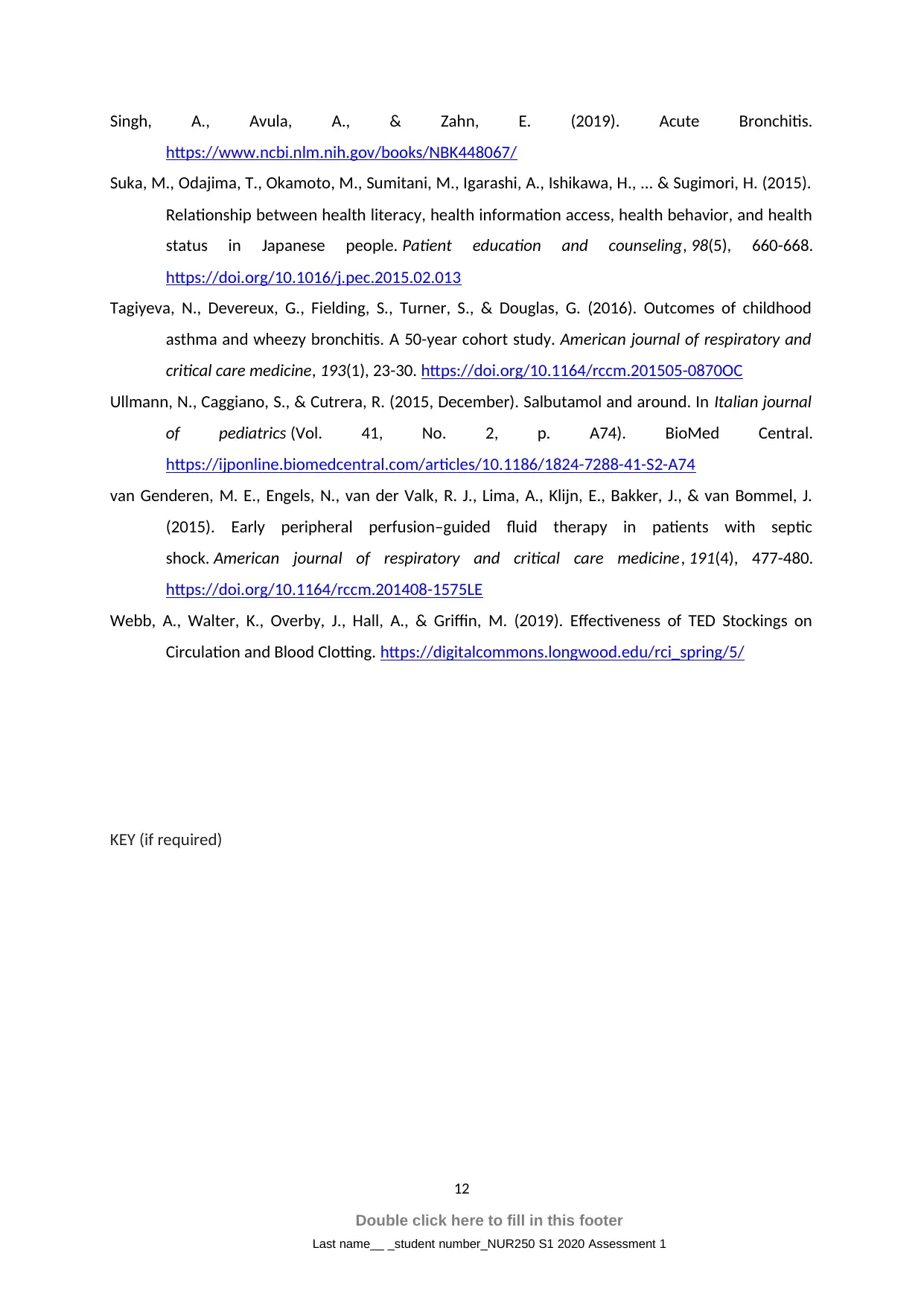
Singh, A., Avula, A., & Zahn, E. (2019). Acute Bronchitis.
https://www.ncbi.nlm.nih.gov/books/NBK448067/
Suka, M., Odajima, T., Okamoto, M., Sumitani, M., Igarashi, A., Ishikawa, H., ... & Sugimori, H. (2015).
Relationship between health literacy, health information access, health behavior, and health
status in Japanese people. Patient education and counseling, 98(5), 660-668.
https://doi.org/10.1016/j.pec.2015.02.013
Tagiyeva, N., Devereux, G., Fielding, S., Turner, S., & Douglas, G. (2016). Outcomes of childhood
asthma and wheezy bronchitis. A 50-year cohort study. American journal of respiratory and
critical care medicine, 193(1), 23-30. https://doi.org/10.1164/rccm.201505-0870OC
Ullmann, N., Caggiano, S., & Cutrera, R. (2015, December). Salbutamol and around. In Italian journal
of pediatrics (Vol. 41, No. 2, p. A74). BioMed Central.
https://ijponline.biomedcentral.com/articles/10.1186/1824-7288-41-S2-A74
van Genderen, M. E., Engels, N., van der Valk, R. J., Lima, A., Klijn, E., Bakker, J., & van Bommel, J.
(2015). Early peripheral perfusion–guided fluid therapy in patients with septic
shock. American journal of respiratory and critical care medicine, 191(4), 477-480.
https://doi.org/10.1164/rccm.201408-1575LE
Webb, A., Walter, K., Overby, J., Hall, A., & Griffin, M. (2019). Effectiveness of TED Stockings on
Circulation and Blood Clotting. https://digitalcommons.longwood.edu/rci_spring/5/
KEY (if required)
12
Double click here to fill in this footer
Last name__ _student number_NUR250 S1 2020 Assessment 1
https://www.ncbi.nlm.nih.gov/books/NBK448067/
Suka, M., Odajima, T., Okamoto, M., Sumitani, M., Igarashi, A., Ishikawa, H., ... & Sugimori, H. (2015).
Relationship between health literacy, health information access, health behavior, and health
status in Japanese people. Patient education and counseling, 98(5), 660-668.
https://doi.org/10.1016/j.pec.2015.02.013
Tagiyeva, N., Devereux, G., Fielding, S., Turner, S., & Douglas, G. (2016). Outcomes of childhood
asthma and wheezy bronchitis. A 50-year cohort study. American journal of respiratory and
critical care medicine, 193(1), 23-30. https://doi.org/10.1164/rccm.201505-0870OC
Ullmann, N., Caggiano, S., & Cutrera, R. (2015, December). Salbutamol and around. In Italian journal
of pediatrics (Vol. 41, No. 2, p. A74). BioMed Central.
https://ijponline.biomedcentral.com/articles/10.1186/1824-7288-41-S2-A74
van Genderen, M. E., Engels, N., van der Valk, R. J., Lima, A., Klijn, E., Bakker, J., & van Bommel, J.
(2015). Early peripheral perfusion–guided fluid therapy in patients with septic
shock. American journal of respiratory and critical care medicine, 191(4), 477-480.
https://doi.org/10.1164/rccm.201408-1575LE
Webb, A., Walter, K., Overby, J., Hall, A., & Griffin, M. (2019). Effectiveness of TED Stockings on
Circulation and Blood Clotting. https://digitalcommons.longwood.edu/rci_spring/5/
KEY (if required)
12
Double click here to fill in this footer
Last name__ _student number_NUR250 S1 2020 Assessment 1
⊘ This is a preview!⊘
Do you want full access?
Subscribe today to unlock all pages.

Trusted by 1+ million students worldwide
1 out of 12
Related Documents
Your All-in-One AI-Powered Toolkit for Academic Success.
+13062052269
info@desklib.com
Available 24*7 on WhatsApp / Email
![[object Object]](/_next/static/media/star-bottom.7253800d.svg)
Unlock your academic potential
Copyright © 2020–2025 A2Z Services. All Rights Reserved. Developed and managed by ZUCOL.





